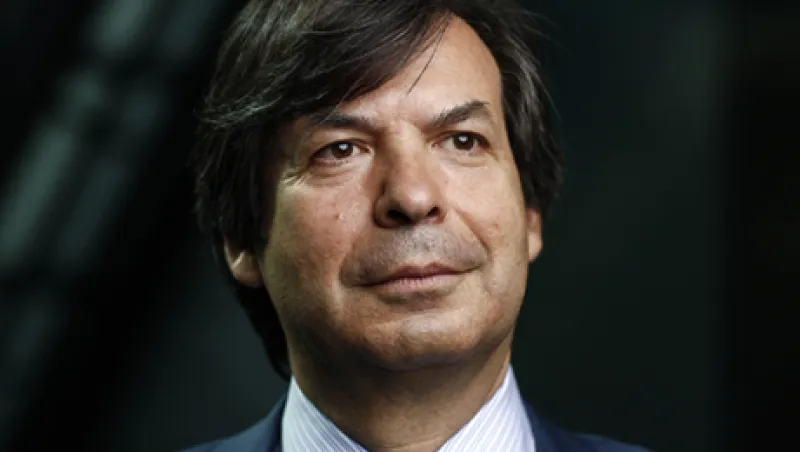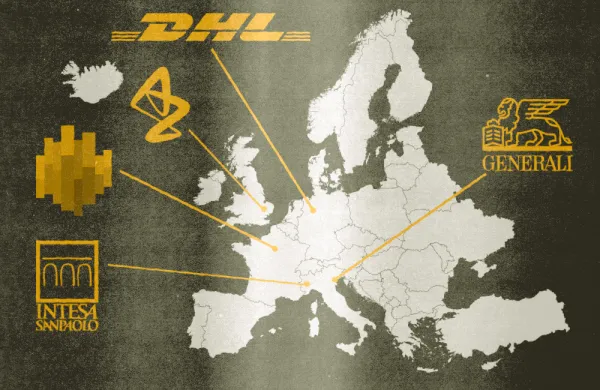Carlo Messina has an Italian problem. The chief executive of Intesa Sanpaolo runs one of the strongest banks in Europe by many metrics, with solid profitability, a low cost-to-income ratio and a lofty capital buffer. Yet Intesa is tarred with the very broad brush of Italy’s wider economic and financial woes.
Europe’s fourth-largest economy has endured a triple-dip recession since the global financial crisis, and even with a modest recovery that began last year, output remains 10 percent below the precrisis peak. Only the bailout states of Cyprus, Greece and Portugal have fared worse among euro area countries.
That economic decline has taken a heavy toll on Italy’s banking sector, which lumbers under the weight of €360 billion ($400 billion) in nonperforming loans (NPLs). Efforts to consolidate four struggling popolari, or mutual, lenders last year triggered a big sell-off of bank stocks as investors extrapolated the depressed recovery values of those banks’ bad loan books to the entire sector. Bank stocks took another hit earlier this year when Italy’s largest lender by assets, UniCredit, failed to attract investors to a €1.5 billion capital raising it underwrote for another regional lender, Banca Popolare di Vicenza, spurring fears UniCredit could be left on the hook. The government muscled banks and insurers to pony up a €5 billion fund, Atlante, to backstop the Vicenza deal, but confidence in the sector has continued to ebb.
Shares came under pressure again in July after a government-organized rescue plan for Banca Monte dei Paschi di Siena — the world’s oldest bank and Italy’s third largest — raised fresh doubts about loan quality. MPS, which flunked a European Union stress test, will seek to raise €5 billion in fresh equity later this year after securitizing its €28 billion bad-loan portfolio at a price of 33 cents on the dollar.
Having the most positive story in Italian banking, as Messina does, wins little credit these days. Intesa’s stock closed at €1.82 a share on August 3, down 50 percent from its July 2015 high.
Messina, 54, spent 18 years rising through the ranks of Intesa and its predecessor, Banco Ambrosiano Veneto, becoming head of retail before being named CEO in 2013. He is forging ahead with a four-year restructuring program that aims to more than triple earnings by 2017 by shedding noncore assets, cutting costs in the group’s Italian corporate and retail banking businesses, and expanding in the capital-light, fee-generating fields of asset and wealth management and insurance. Messina is confident of success because Intesa’s franchise rests on serving households and family-owned companies in northern Italy — still one of Europe’s wealthiest regions, he notes — and the economy continues to recover, albeit at a tepid rate of just under 1 percent. Net income fell 14.8 percent in the first half of 2016, to €1.71 billion, as the European Central Bank’s negative interest rates depressed net interest margins, but lending revived, fee and commission income increased at a healthy 10 percent pace, asset quality improved slowly, and the bank passed the EU stress test with flying colors, with a common equity tier-1 capital ratio of 12.9 percent.
“We are the only large European bank in such a strong position,” Messina told analysts in presenting the bank’s results. “In a rational market we should have the benefit of a lower cost of capital compared to our peers. But I don’t know if the market is rational.”
Messina has sharpened Intesa’s discipline, carefully allocating capital to areas that can generate solid returns, says Davide Serra, founder and CEO of Algebris Investments. “He’s top-class,” says Serra, whose $4.3 billion, London-based hedge fund firm owns roughly $300 million of Intesa stock and debt.
Messina met recently with International Editor Tom Buerkle at his Milan office to discuss his strategy and the challenges facing Italy and its banks.
Institutional Investor: How strong, or weak, is the Italian banking sector?
Messina: In September last year the Italian banking system was one of the best stock performers in the world, yet it had the same amount of nonperforming loans, the same provision coverage as today. It is typical of the market that when some hedge fund decides to take a position against a banking sector, they can move expectations. And in moving expectations, it is typical that you have a period of negative performance.
Then you had a really significant mistake made in the resolution of four minor banks in Italy by imposing a bail-in on the banks’ subordinated debt, which hit the savings of retail clients. That sort of mismanagement should never have happened. We succeeded in transforming this resolution into a killing factor for the Italian banking system.
But if a capital raising by one popolare bank can foster doubts about the largest bank in the country, UniCredit, what does that say about the sector?
Today the flow of negative news is on nonperforming loans in Italy, but the position of nonperforming loans, if you consider the collateral, is much better than the position in other European countries. And in Italy we have zero level-1 assets. We have zero derivatives, zero exposure to something that is pervasive in the other banking sectors, particularly the German and French ones.
In Italy we have a big amount of nonperforming loans deriving from the 10 percent decline in GDP since the global financial crisis, but the country is in a recovery mood and the real estate market is rebounding. So the collateral is recovering.
Many analysts say the Atlante fund is too small. Fair criticism?
We set up an instrument that can be a market maker, not an instrument that can buy all the nonperforming loans. There is no European banking system, or even the U.S. banking system, that has zero nonperforming loans. But if the solution is to create a market for nonperforming loans, Atlante is a solution. The fund can subscribe to a junior or private equity tranche. And in each transaction the banks will have to subscribe to junior tranches. And then there is the possibility to have mezzanine tranches with yields that can attract insurance companies and pension funds. So the real potential is close to €30 billion. If you have the possibility to significantly reduce the stock of NPLs, it’s really a good solution.
Do you think we’ll see a significant increase in the pace of bad-loan sales?
That’s happening. Banks are receiving offers from private equity funds at prices that are much higher than two months ago just because you have a market maker in the market. This is not the case with Intesa Sanpaolo because we have no need to make disposals.
We also have reached a very important point in the real economy in Italy: the recovery of transactions in the real estate market. The number of transactions increased by 20 percent in the past year and prices stabilized.
What benefits are you getting from your restructuring program, and what do you need to do in the next two years?
We are really in a very good position if we compare the bank today with the starting point. We are probably now one of the top players in Europe. We reduced both nonperforming loans and noncore assets.
The engine for growth that we promised to the market two years ago is really creating significant value for our shareholders. We reached a cost-to-income ratio that is now best-in-class in Europe, deriving from revenue increases and cost control. What we need is only to reduce the cost of credit. This is a bank that will remain between 45 and 50 percent cost to income if we can reduce the cost of risk [bad debt provisions] to below 80 basis points, the plan’s target for 2017. And that is absolutely possible because the cycle is coming back to the precrisis situation. The inflow of new nonperforming loans is really minimal.
You registered good loan growth in the first half. Is the economy on the mend?
Absolutely. In Italy there is a significant increase in consumption arising from internal demand. Families had invested in a lot of asset management products that were affected by the Lehman crisis. Then they moved into Italian government bonds and real estate. When the public debt crisis hit in 2011, they were affected by the increase of bond yield spreads from 100 basis points to 550. You feel yourself to be poor because you have a negative mark to market, so you decide to cut consumption. On the other side, the government increased taxes on real estate. So families decided to say: “Okay, I will stay out of consumption. I will remain rich if I make no disposal because I will not take any kind of loss.”
The spread has now moved back to a range of 100, 150 basis points, and families are feeling rich again. They are increasing their demand for products, and companies are increasing investment. So loans are increasing. Internal demand is bringing growth to around 1 percent. That is not an emerging-market rate, but it is the growth rate that Italy used to have before the crisis.
What kind of lending growth do you think the bank can sustain this year and next?
We’re looking at the potential to grow between 2 and 3 percent in the loan book. What we consider strategic is mortgages with retail clients because this is an area where we are gaining significant market share. And we consider it strategic for cross-selling in the retail network because the second step of our business plan is establishing one of the best wealth management companies in Europe.
How do you grow this business?
We think there is a significant potential to create a leading company in Europe because we have €150 billion of assets under administration that can be switched into assets under management, and we have more or less €50 billion of deposits that can be switched into assets under management. And we attracted more deposits from other banks in Italy. In just one quarter we increased deposits by €10 billion.
We are creating products that guarantee a portion of capital for the clients and guarantee some yield. The target is clear: We want to convert the majority of this potential that we have within our company, and we are sure that we can do it.
Do you think we’re going to get a recovery that will allow the ECB to raise rates?
After two years there will be, in my view, an increase in interest rates because there are situations that are not sustainable for more than two years. Insurance companies have significant power in countries that are much stronger than Italy. If you look at Germany, there are a lot of players that can be affected by negative interest rates.
In two years’ time there could be a recovery in the real economy and they will have to stop this quantitative easing attitude, so they will move into a more realistic approach. We need to be in a position to benefit from this recovery in interest rates. We will have to have completed all the restructuring of the bank because these strong benefits coming from quantitative easing will end.
Are you satisfied with the pace of reform that Prime Minister Renzi is making?
Yes, absolutely. He’s doing what, in Italy, no one has done in 20 years. In a year and a half, he succeeded in making a number of reforms that, in my view, are really important for my country. If you look at unemployment, you can see the immediate benefits of the labor market reforms.
He’s also promised to reform the bankruptcy code. How significant is that?
[Finance Minister Pier Carlo] Padoan has passed a reform that reduces the time of recovery from seven years to two or three years. That could be very significant for the recovery actions of Intesa Sanpaolo. This reform is very good for the banking sector and for the real economy in Italy. The expectation is that this can improve the prices of nonperforming loans by increasing the recovery rate and speeding up the process of recovery. The impact could be 5, 10 percent of the price of NPLs.
Are you worried about fragmentation within Europe following the Brexit vote?
It is clear that you can have two possibilities, from a political point of view. One is a fragmentation. The other is to work in a serious way in order to create an infrastructure that can work as the Ministry of Finance for Europe, accelerating the process of integration. My expectation is that there could be an acceleration of this process of creating a real political entity in Europe. Brexit can lead politicians to look at the interest of Europe and not only at the interest of their country.
Investors say your biggest weakness is that Intesa is so tied to the Italian economy. What do you say to that?
Until last September investors told us, “You are the European Wells Fargo; you are very easy to manage and understand.” Today we hear, “Okay, you are good” — because all the comments on the bank and the management are really positive — “but you are Italian.”
My position is that we are so strong because we are Italian. Our possibility to leverage our wealth management is derived from the fact that we are Italian. And we are working with a very triple-A part of our country — that is, the savings of the family. •
Visit Tom Buerkle’s blog and follow him on Twitter at @tombuerkle.






